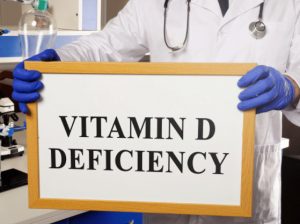
Vitamin D – what is its optimal level, and how to achieve it?
 Vitamin D – what is its optimal level, and how to achieve it?
Vitamin D – what is its optimal level, and how to achieve it?
All substances included in the group of vitamins play a vital role in the human body’s processes. This does not mean, however, that they are compounds with similar properties. Quite the contrary! Individual vitamins may differ in many respects. For example, the human body cannot produce vitamin C on its own. However, the synthesis of vitamin D is possible. Despite this, people around the world struggle with the problem of deficiency of this vitamin. So what should be done to get adequate levels of vitamin D?
How does vitamin D work?
Generally, two types of vitamin D can be distinguished. The first is ergocalciferol, also known as vitamin D2. This compound is found primarily in plant products, mushrooms, and yeast. However, it is cholecalciferol (vitamin D3) that has attracted much more attention from researchers. Such a substance can be found mainly in animal products.
Why then is almost all the attention of scientists focused on vitamin D3? This is due to two crucial reasons. First, cholecalciferol shows a much higher efficiency of action. Researchers suggest that this form raises overall vitamin D levels in the body faster. Second, animals and humans can produce cholecalciferol on their own. This phenomenon occurs when exposed to ultraviolet rays (known as UVB rays). Unfortunately, the efficiency of this synthesis depends on several factors. For more information, see the last section of this article.
 The action of vitamin D is extremely broad. One of its main tasks is to increase the absorption of calcium and phosphorus. Both of these elements strengthen bones and improve their mineralization. In addition, vitamin D stimulates the immune system. This allows the body to cope better with various pathogens. What is more, researchers are publishing more and more evidence that vitamin D can also effectively prevent certain cancers.
The action of vitamin D is extremely broad. One of its main tasks is to increase the absorption of calcium and phosphorus. Both of these elements strengthen bones and improve their mineralization. In addition, vitamin D stimulates the immune system. This allows the body to cope better with various pathogens. What is more, researchers are publishing more and more evidence that vitamin D can also effectively prevent certain cancers.
People who practice strength sports should also know about the impact of vitamin D on muscle function. Its deficiency can therefore weaken both bone structure and muscle tissue.
What is the optimal level of vitamin D in the blood?
Despite appearances, determining the correct level of vitamin D in the blood is not that simple. Scientists have found that the need for this compound may vary from person to person. Factors such as age, skin color, and already diagnosed vitamin D deficiency play an essential role.
To make matters worse, different research institutes are guided by different standards. In principle, they all agree that a blood level of vitamin D of less than 20 ng/ml indicates a deficiency. However, the determination of the optimal level raises more questions. Some researchers believe that all values above 20ng/ml are average. Others indicate a range of 30-40 ng/ml as the optimal level. Some even give discounts of 50-80 ng/ml in the case of adults.
So it is difficult to say which of the above recommendations is the best. Perhaps the truth, as usual, lies somewhere in the middle. Therefore, maintaining the level of 30-50 ng/ml seems to be reasonable. The dangerous concentration of vitamin D in the blood can be said when its value exceeds 150 ng/ml.
What needs to be done to get the required vitamin D levels?
It is already known that achieving adequate levels of vitamin D in the blood is extremely important. However, the critical question remains – how can this be done?
 Basically, there are several ways to provide your body with vitamin D. One of the more apparent solutions is getting out in the fresh air and enjoying the sun. Unfortunately, there is a problem here. Well, UVB rays are not always intense enough to stimulate the body to synthesize vitamin D3. According to scientists in the European climate, such a possibility exists only from March/April to October. This means that the winter sun does not provide natural vitamin D.
Basically, there are several ways to provide your body with vitamin D. One of the more apparent solutions is getting out in the fresh air and enjoying the sun. Unfortunately, there is a problem here. Well, UVB rays are not always intense enough to stimulate the body to synthesize vitamin D3. According to scientists in the European climate, such a possibility exists only from March/April to October. This means that the winter sun does not provide natural vitamin D.
Interesting fact:
Vitamin D synthesis does not occur when the skin is isolated from the sun. So if someone looks at the sun through a window, for example, the UVB rays won’t reach their skin because the glass will stop them. The same is true when walking outside in long pants and outerwear. Doctors indicate that useful synthesis of vitamin D3 during the summer requires at least 20% of the body surface to be exposed. Also, the exposure itself should last about 15-20 minutes.
Although the body can produce vitamin D3 independently, everyone can increase its supply by adjusting their diet. For this purpose, it is worth focusing primarily on oily marine fish. Why? Because vitamin D3 is a fat-soluble compound. Therefore, people who are on a low-fat diet may have considerable problems in this regard.
Fortunately, vitamin D3 supplementation is also an effective alternative. In most European countries, doctors recommend supplementation of this compound during autumn and winter. Then it is not possible to obtain vitamin D3 through natural synthesis. Unfortunately, it is difficult to indicate the ideal dose of cholecalciferol recommended during supplementation. As a rule, healthy people can be recommended values of 1000-2000 IU. (25-50 micrograms). Admittedly, some people take even twice as much. However, some doctors say that 100 micrograms (4000 IU), for example, is too high a dose for people living in this climate zone.
Summary
Taking into account all mentioned alternatives – supplementation of vitamin D3 seems to be the best solution. You can be sure that its level will not depend on external factors (e.g., weather, sunlight). Also, vitamin D3 itself is difficult to overdose on because its excess is effectively broken down. Of course, during the summer, the blood levels of this compound are usually high enough. However, in winter, vitamin D3 supplementation will definitely be advisable!



